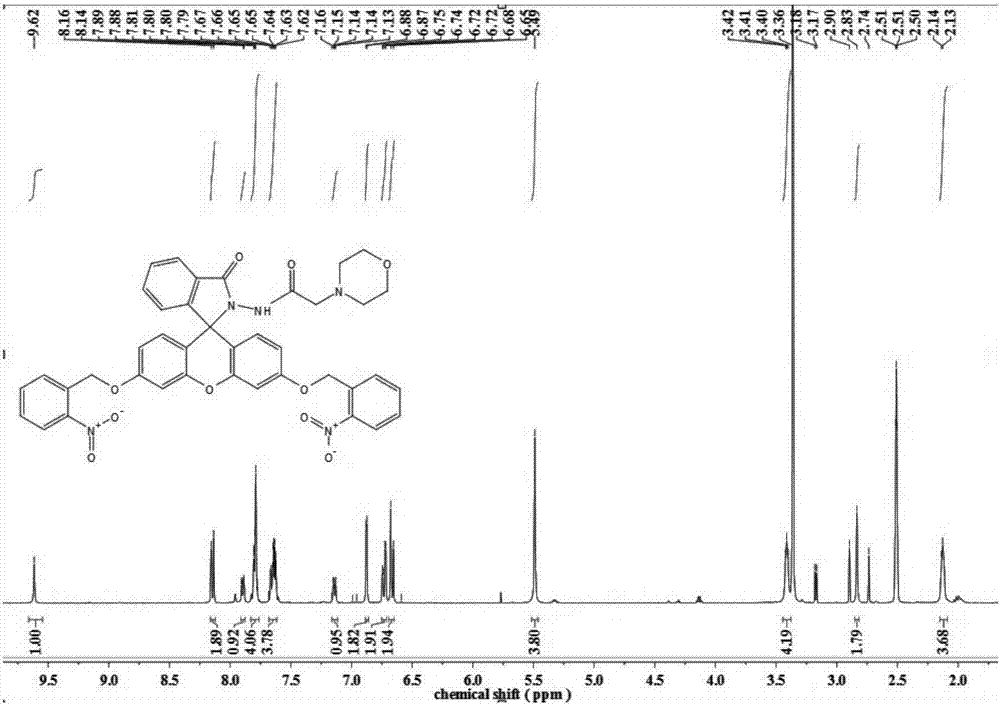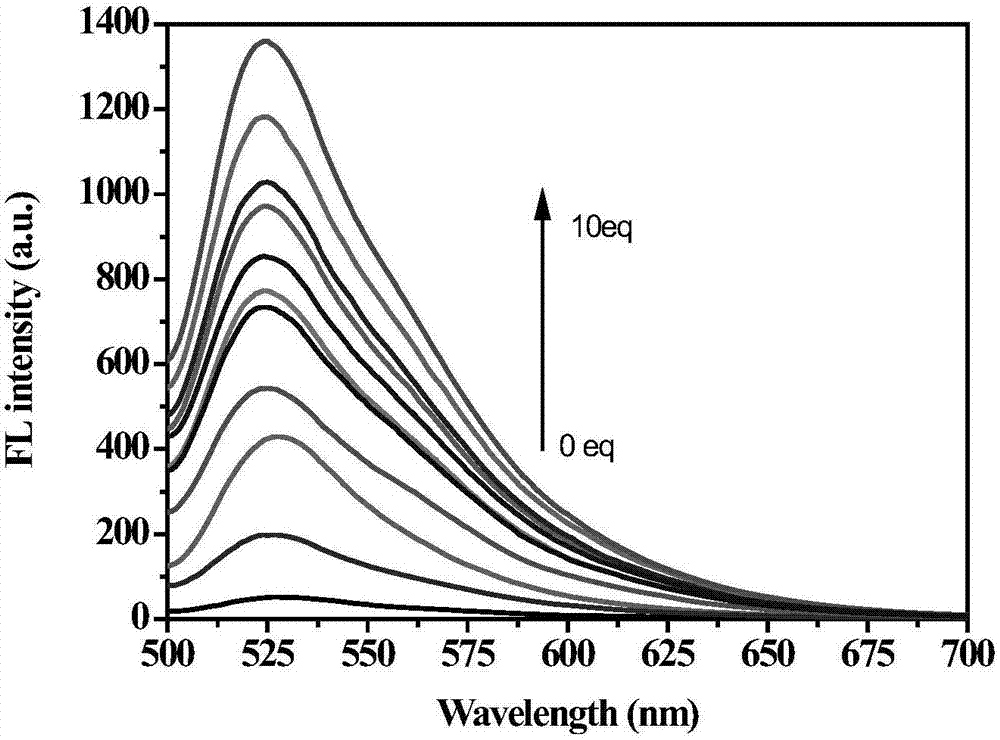Lysosome targeted hypochloric acid fluorescent probe and preparation and application thereof
A fluorescent probe, hypochlorous acid technology, applied in the field of analytical chemistry, can solve problems such as loss, and achieve the effects of strong specificity, simple product purification, and low detection limit
- Summary
- Abstract
- Description
- Claims
- Application Information
AI Technical Summary
Problems solved by technology
Method used
Image
Examples
Embodiment 1
[0033] Example 1 Synthesis of fluorescent probe Lyso-HClO-UV.
[0034] (1) Fluorescein (3.0mmol, 1.0g) was dissolved in 50ml of methanol, 80% hydrazine hydrate (4ml) was added dropwise, refluxed for 5h, cooled to room temperature, the solvent was spinned out, and pure product FLN was obtained by column chromatography with a yield of 80 %.
[0035] (2) Compound FLN (1.7mmol, 600mg), o-nitrobenzyl bromide (5.2mmol, 1.2g) and cesium carbonate (3.4mmol, 1.1g) were dissolved in DMF (3ml), under nitrogen protection conditions, stirred at room temperature for 6h, Then it was poured into 300ml ethyl acetate, washed with 300ml water three times, dried over anhydrous sodium sulfate, filtered, and column chromatographed (ethyl acetate:petroleum ether=1:2) to obtain the compound FLNph with a yield of 78%. 1 H NMR (400MHz, DMSO) δ8.14 (d, J = 8.1Hz, 2H), 7.83–7.78 (m, 5H), 7.66–7.62 (m, 2H), 7.52 (dd, J = 5.5, 3.1Hz, 2H),7.05–7.01(m,1H),6.93(d,J=2.4Hz,2H),6.73(dd,J=8.8,2.5Hz,2H),6.57(d,J...
Embodiment 2
[0038] Example 2 Fluorescence intensity of fluorescent probe Lyso-HClO-UV changes with HClO concentration.
[0039] The Lyso-HClO-UV hypochlorous acid fluorescent probe prepared in Example 1 was dissolved in N,N-dimethylformamide (DMF) to prepare a 1 mmol / L stock solution. Take 20uL from the stock solution and add it to a 5mL centrifuge tube, dilute to 4mL with 0.1mol / L, pH=7.4 phosphate buffered saline (PBS) and DMF volume ratio of 2:1, add different equivalents (0- 100 μM) of NaClO standard solution (NaClO will spontaneously produce acid-base balance shift in aqueous solution under neutral conditions to produce HClO, the same below), irradiate with 365nm ultraviolet light for 10min, and use 480nm as the excitation wavelength to measure its fluorescence spectrum. Fluorescence spectra such as figure 2 shown. Taking the concentration of NaClO as the abscissa and the fluorescence intensity as the ordinate, we can get image 3 . Depend on Figure 2-3 It can be seen from the...
Embodiment 3
[0040] Example 3 The change of fluorescence intensity of fluorescent probe Lyso-HClO-UV with ultraviolet light irradiation time.
[0041] Take 20 μL from the medium fluorescent probe stock solution in Example 2 and add it to a 5mL centrifuge tube, dilute it to 4mL with a solution of PBS (0.1mol / L, pH=7.4) and DMF with a volume ratio of 2:1, add The 100 μM NaClO standard solution was irradiated with 365 nm ultraviolet light, and its fluorescence spectrum was measured every 15 s within 0-330 s. The detection conditions were as in Example 2. With the increase of ultraviolet light irradiation time, the change of the fluorescence spectrum of the solution, such as Figure 4 As shown, the abscissa is the wavelength, and the ordinate is the relative fluorescence intensity. Depend on Figure 4 It can be seen that after hypochlorous acid was added to the probe solution, the fluorescence intensity gradually increased with the increase of ultraviolet light irradiation time.
PUM
 Login to View More
Login to View More Abstract
Description
Claims
Application Information
 Login to View More
Login to View More - R&D
- Intellectual Property
- Life Sciences
- Materials
- Tech Scout
- Unparalleled Data Quality
- Higher Quality Content
- 60% Fewer Hallucinations
Browse by: Latest US Patents, China's latest patents, Technical Efficacy Thesaurus, Application Domain, Technology Topic, Popular Technical Reports.
© 2025 PatSnap. All rights reserved.Legal|Privacy policy|Modern Slavery Act Transparency Statement|Sitemap|About US| Contact US: help@patsnap.com



